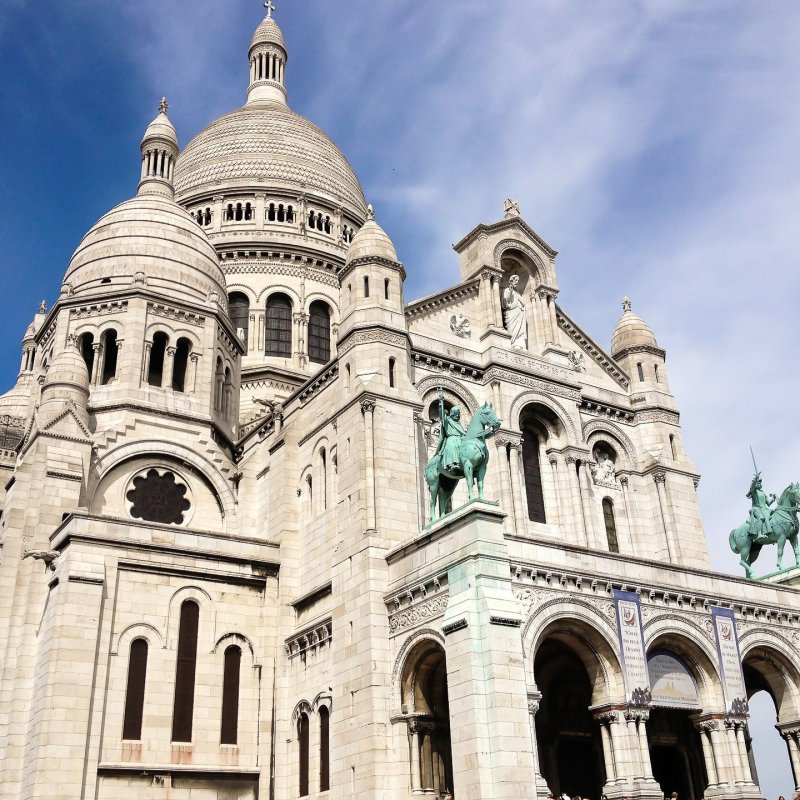
The tragic fire at Notre Dame Cathedral has left many travelers reworking their bucket lists. Where else can they go to worship? Where else can they admire beautiful stained glass? Where else can they appreciate Paris’s history, architecture, and art? Fortunately, Paris is absolutely brimming with spectacular houses of worship that inspire travelers. Here are five incredible sites you won’t want to miss.
Videos by TravelAwaits

1. Sacré-Cœur Basilica
The Parisian hilltop neighborhood of Montmartre is, in many ways, the Paris of your dreams. There are sweet little cafés on narrow cobblestone streets; there are bohemian artists with charcoal-stained fingers, sketching and scowling with cigarettes hanging from their mouths. Sometimes, though, Montmartre is a bit of a nightmare: The pickpockets are especially agile there! But no matter what, your visit to the area should center on Sacré-Cœur Basilica.
The Basilica of the Sacred Heart of Paris, commonly known as Sacré-Cœur Basilica, is Paris’s most famous house of worship after Notre Dame. It was designed by Paul Abadie; construction began in 1875 and was completed in 1914. The overall style of the structure is Romano-Byzantine, but many visitors say the church most closely resembles a wedding cake! It’s massive, bright white, and lusciously decorated. The basilica’s belfry is notable for being home to the largest bell in all of France (and the fourth-largest bell in Europe).
Visitors eager to see the basilica often miss the meditation garden and fountain that are part of its property. Perhaps that’s not a surprise, since the views of Paris from the steps leading to the basilica are the main draw. For those who don’t mind a bit of a leg workout, the top of the basilica’s dome is open to the public and offers the most spectacular views of all.

Practical Matters
Visitors are not permitted to use cameras or video recorders inside the basilica.
Sacré-Cœur is open daily from 6 a.m. to 11:30 p.m. The dome is open daily from 9 a.m. to 7 p.m. in the summer and from 9 a.m. to 6 p.m. in the winter. There are long lines to enter, especially on weekends and around midday. Arrive early, and you might just be alone with the staff and the faithful. General admission is free, but there’s a small fee to visit the dome.
Those Montmartre pickpockets don’t just hang out in the neighborhood — they’re in the church itself. Keep your belongings in a closed crossbody bag, not in an open over-the-shoulder tote bag.
Don’t forget to visit the nearby (and often overlooked) Musée de Montmartre. This 17th-century manor house is the oldest building in the neighborhood!

2. Sainte-Chapelle
Few houses of worship have as rich a patrimony as Sainte-Chapelle on the Île de la Cité. The stunning chapel was constructed between 1241 and 1248 during the reign of Louis IX, who was canonized by the Catholic Church in 1297; the structure was intended to house Christ’s Crown of Thorns and a piece of the true Cross. Some of the precious relics were destroyed in 1789 during the French Revolution, but Sainte-Chapelle’s exquisite stained glass windows remain intact. Through them, you can get a sense of what life would have been like for early worshippers. The windows tell the stories of the Old and New Testaments as well as the story of the relics.
After being abandoned following the French Revolution, Sainte-Chapelle underwent a 26-year restoration. Even though the chapel isn’t entirely in its original condition, it’s still magnificent, and the Gothic design is still as beautiful as it ever was.

Practical Matters
Sainte-Chapelle is open daily from 9 a.m. to 5 p.m. from October through March, and from 9 a.m. to 7 p.m. from April through September.
Admission costs 10 euros for adults, 8 euros for students and seniors, and is free for residents of the European Union under the age of 25.

3. La Madeleine
L’église Sainte-Marie-Madeleine, better known as La Madeleine, looks more like a Roman temple than a Parisian church. In 1806, Napoleon Bonaparte commissioned the neoclassical building in the 8th arrondissement as a temple to the glory of his armies; in 1845, the structure was converted to a church dedicated to the life and memory of Mary Magdalene. Before 1806, the property was the site of several churches, including one demolished in 1799 that marked the original burial spot of Louis XVI. Legislation passed during the French Revolution forbade him from being buried next to the remains of his father in order to minimize pilgrimages by royalists.
Inside, the structure, with its three domes and lavishly gilded decor, resembles an opulent Roman bath. There are columns, sculptures, and paintings in abundance. It’s a building unlike any other in Paris.
Practical Matters
La Madeleine is open daily from 9:30 a.m. to 7 p.m. During Mass and religious services, touring is prohibited, though guests are welcome to worship with the congregation. Admission is free, and the church often hosts free organ recitals.
La Madeleine is also home to a secret restaurant that’s one of the best bargains in Paris. In the basement of the church is Foyer de la Madeleine, which is open on weekdays from 11:30 a.m. to 2 p.m. except on holidays, school vacations, and during the month of August. For a yearly subscription fee of 5 euros you can purchase a three-course French meal for 8.50 euros. Works by local artists decorate the walls, and you can get some of Paris’s cheapest espresso in the lounge — just 80 centimes!

4. Saint-Germain-Des-Prés
In the heart of Paris’s most creative neighborhood, where artists and writers generate the most modern ideas, lies the oldest church in the city, Saint-Germain-des-Prés. Construction started in A.D. 543 (yes, you read that correctly!). Originally a royal abbey devoted to the Holy Cross, it was rebuilt in the Gothic style in the 10th century, making it one of the first Gothic churches in the world. The rebuild was necessary following a conflict with Vikings that left the original church severely damaged. After the French Revolution, all abbeys were closed, and Saint-Germain-des-Prés served as a factory until it reopened as a church in 1803. It’s hard to imagine a house of worship more steeped in history — if only the walls could talk!

Practical Matters
Saint-Germain-des-Prés is open daily from 8 a.m. to 7:45 p.m. Admission is free.

5. Panthéon
The Panthéon of Paris has the distinction of having once been a church — and a very influential one at that — but today it is a secular mausoleum where several important citizens are buried.
Originally a church dedicated to Saint Genevieve (who was buried on the land where the church now stands), the Panthéon was constructed in 508 under the direction of Clovis, King of the Franks. During the Middle Ages, it was a site of religious scholarship, but by the mid-1700s, it had fallen into serious disrepair. King Louis XV decided to replace the older building with a grand new structure more suitable to house the relics of the patroness of Paris. Monumental events stalled the project again and again, the most significant being the outbreak of the French Revolution, when the Panthéon was converted to a temple to liberty. Voltaire’s ashes were interred there in 1791, and a number of French heroes soon followed, including Jean-Jacques Rousseau, Victor Hugo, Émile Zola, Pierre and Marie Curie, Alexandre Dumas, and Louis Braille. While technically no longer a church, the atmosphere remains similar to that of a church. Keep an eye out for Foucault’s pendulum, first installed in 1851, removed, and then reinstalled in 1995.

Practical Matters
The Panthéon of Paris is open daily from 10 a.m. to 6:30 p.m.
Admission costs 9 euros for adults, 7 euros for students, and is free for residents of the European Union under the age of 25.
Expect a security check upon entry. All bags are checked, and large luggage is not allowed.
